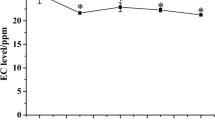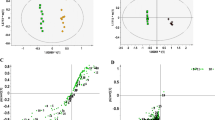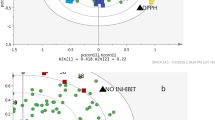Abstract
Soybean polypeptide TTYY has substantial antioxidant activity. The present study aimed to investigate the mechanisms of the potential ability of TTYY to allow rats to recover from oxidative damage using 1H-NMR-based metabonomics. Male Wistar rats received injections of d-galactose to establish the oxidative damage model, then gavaged with TTYY. After treatment, principal component analysis and partial least squares-discriminant analysis were performed to identify different metabolic profiles based on the 1H-NMR spectra of urine from rats and liver antioxidant capacity analysis were also performed. The oxidation-induced changed in biological endpoints were reversed to a certain extent in the rats treated with TTYY compared with the control group. The potential biomarkers in the urine were identified as follows: pyruvate, 2-ketoglutarate, alanine, glycine, citrate, creatine, lactate, and acetate. The results show that TTYY may counterbalance the oxidative damage induced by d-galactose, and most likely plays a role in the changes observed in certain metabolic pathways including those involved in energy, amino acid, and glycolysis metabolisms.






Similar content being viewed by others
References
Beckonert O, Keun HC, Ebbels TM, Bundy J, Holmes E, Lindon JC, Nicholson JK (2007) Metabolic profiling, metabolomic and metabonomic procedures for NMR spectroscopy of urine, plasma, serum and tissue extracts. Nat Protoc 2:2692–2703
Bradford MM (1976) A rapid and sensitive method for the quantification of microgram quantities of protein utilizing the principle of protein–dye binding. Anal Biochem 72:248–254
Calcutt NA, Cooper ME, Kern TS, Schmidt AM (2009) Therapies for hyperglycaemia-induced diabetic complications: from animal models to clinical trials. Nat Rev Drug Discov 8:417–429
Capriotti A, Caruso G, Cavaliere C, Samperi R, Ventura S, Chiozzi RZ, Laganà A (2015) Identification of potential bioactive peptides generated by simulated gastrointestinal digestion of soybean seeds and soy milk proteins. J Food Compos Anal 44:205–213
Chen HM, Muramoto K, Yamauchi F (1995) Structural analysis of antioxidative peptides from soybean b-conglycynin. J Agric Food Chem 43:574–578
Christopher BME, Jochen HBS (2009) Anti-oxidative capacity of enzymatically released peptides from soybean protein isolate. Eur Food Res Technol 229:637–644
Coen M, Holmes E, Lindon JC, Nicholson JK (2008) NMR-based metabolic profiling and metabonomic approaches to problems in molecular toxicology. Chem Res Toxicol 21:9–27
Dai YT, Li ZY, Xue LM, Dou CH, Zhou YZ, Zhang LZ, Qin XM (2010) Metabolomics study on the anti-depression effect of xiaoyaosan on rat model of chronic unpredictable mild stress. J Ethnopharmacol 128:482–489
Elias RJ, Kellerby SS, Decker EA (2008) Antioxidant activity of proteins and peptides. Crit Rev Food Sci Nutr 48:430–441
Fan SH, Zhang ZF, Zheng YL, Lu J, Wu DM, Shan Q, Hu B, Wang YY (2009) Troxerutin protects the mouse kidney from d-galactose-caused injury through anti-inflammation and anti-oxidation. Int J Immunopharmacol 9:91–96
Gao XY, Guo MX, Zhao BS, Peng L, Su JK, Bai X, Li J, Qiao YJ (2013) A urinary metabonomics study on biochemical changes in yeast-induced pyrexia rats: a new approach to elucidating the biochemical basis of the febrile response. Chem Biol Interact 204:39–48
Gartland KPR, Bonner FW, Nicholson JK (1989) Investigations into the biochemical effects of region-specific nephrotoxins. Mol Pharmacol 35:242–250
Goldsmith PMB, Ch B, Fenton HBS, Morris GSMD, Ahmad NMD, Fisher JPD, Rajendra KPFRCS (2010) Metabonomics: a useful tool for the future surgeon. J Surg Res 160:122–132
Hua YL, Xue WX, Zhang M, Wei YM, Ji P (2014) Metabonomics study on the hepatoprotective effect of polysaccharides from different preparations of Angelica sinensis. J Ethnopharmacol 151:1090–1099
Huo TG, Chen X, Lu XM, Qu LY, Liu Y, Cai S (2014) An effective assessment of valproate sodium-induced hepatotoxicity with UPLC–MS and 1HNMR-based metabonomics approach. J Chromatogr B 969:109–116
Jung J, Park M, Park HJ, Shim SB, Cho YH, Kim J, Lee HS, Ryu DH, Choi D, Hwang GS (2011) 1H NMR-based metabolic profiling of naproxen-induced toxicity in rats. Toxicol Lett 200:1–7
Knowles SE, Jarrett IG, Filsell OH, Ballard FJ (1974) Production and utilization of acetate in mammals. Biochem J 142:401–411
Lin X, Zhang SJ, Huang RB, Wei L, Tan SM, Liang CH, Lv SJ, Chen YX, Liang S, Tian YC, Lu ZP, Huang QF (2014) Protective effect of madecassoside against cognitive impairment induced by d-galactose in mice. Pharmacol Biochem Behav 124:434–442
Lindon JC, Nicholson JK, Everett JR (1999) NMR spectroscopy of biofluids. Annu Rep NMR Spectrosc 38:1–88
Liu YR, Huang RQ, Liu LJ, Peng JN, Xiao BK, Yang JY, Miao ZC, Huang HL (2010) Metabonomics study of urine from Sprague–Dawley rats exposed to Huang-yao-zi using 1H NMR spectroscopy. J Pharm Biomed Anal 52:136–141
Mamas M, Dunn WB, Neyses L, Goodacre R (2011) The role of metabolites and metabolomics in clinically applicable biomarkers of disease. Arch Toxicol 85:5–17
Menezes AL, Pereira MP, Buzelle SL, dos Santos MP, de França SA, Baviera AM, Andrade CMB, Garófalo MAR, Kettelhut IDC, Chaves VE, Kawashita NH (2013) A low-protein, high-carbohydrate diet increases de novo fatty acid synthesis from glycerol and glycerokinase content in the liver of growing rats. Nutr Res 33:494–502
Nicholson JK, Wilson ID (1989) High resolution proton magnetic resonance spectroscopy of biological fluids. Prog Nucl Magn Reson Spectrosc 21:449–501
Nicholson JK, Lindon JC, Holmes E (1999) ‘Metabonomics’: understanding the metabolic responses of living systems to pathophysiological stimuli via multi-variate statistical analysis of biological NMR spectroscopic data. Xenobiotica 29:1181–1189
Nicholson JK, Connelly J, Lindon JC, Holmes E (2002) Metabonomics: a platform for studying drug toxicity and gene function. Nat Rev Drug Discov 1:153–161
Paradies G, Petrosillo G, Paradies V, Ruggiero FM (2011) Mitochondrial dysfunction in brain aging: role of oxidative stress and cardiolipin. Neurochem Int 58:447–457
Reeves PG, Nielsen FH, Fahey JRGC (1995) AIN-93 purified diets for laboratory rodents: final report of the American Institute of Nutrition ad hoc writing committee on the reformulation of the AIN-76A rodent diet. J Nutr 123:1939–1951
Sang X, Bao M, Li D, Li YM (1999) Advanced glycation in d-galactose induced mouse aging model. Mech Aging Dev 108:239–251
Sangster TP, Wingate JE, Burton L, Teichert F, Wilson ID (2007) Investigation of analytical variation in metabonomic analysis using liquid chromatography mass spectrometry. Rapid Commun Mass Spectrom 21:2965–2970
Singh BP, Vij S, Hati S (2014) Functional significance of bioactive peptides derived from soybean. Peptides 54:171–179
Sun JC, Schnackenberg LK, Holland RD, Schmitt TC, Cantor GH, Dragan YP, Beger RD (2008) Metabonomics evaluation of urine from rats given acute and chronic doses of acetaminophen using NMR and UPLC/MS. J Chromatogr B 871:328–340
Tang B, Ding J, Wu F, Chen L, Yang Y, Song F (2012) 1H NMR-based metabonomics study of the urinary biochemical changes in Kansui treated rat. J Ethnopharmacol 141:134–142
Tian J, Ishibashi K, Reiser K, Grebe R, Biswal S, Gehlbach P, Handa JT (2005) Advanced glycation endproduct-induced aging of the retinal pigment epithelium and choroid: a comprehensive transcriptional response. Proc Natl Acad Sci USA 102:11846–11851
Ullsten S, Danielsson R, Backstrom D, Sjoberg P, Bergquist J (2006) Urine profiling using capillary electrophoresis-mass spectrometry and multivariate data analysis. J Chromatogr A 1117:87–93
Wang W, de Mejia EG (2005) A new frontier in soy bioactive peptides that may prevent age-related chronic diseases. Compr Rev Food Sci Food Saf 4:63–78
Wang X, Sun H, Zhang A, Sun W, Wang P, Wang Z (2011) Potential role of metabolomics apporoaches in the area of traditional chinese medicine: as pillars of the bridge between chinese and western medicine. J Pharm Biomed Anal 55:859–868
Wang XJ, Wang HY, Zhang AH, Lu X, Sun H, Dong H, Wang P (2012) Metabolomics study on the toxicity of aconite root and its processed products using ultraperformance liquid-chromatography/electrosprayionization synapt high-definition mass spectrometry coupled with pattern recognition approach and ingenuity pathways analysis. J Proteome Res 11:1284–1301
Wei L, Liao P, Wu H, Li X, Pei F, Li W, Wu Y (2008) Toxicological effects of cinnabar in rats by NMR-based metabolic profiling of urine and serum. Toxicol Appl Pharmacol 227:417–429
Wei L, Liao P, Wu H, Li X, Pei F, Li W, Wu Y (2009) Metabolic profiling studies on the toxicological effects of realgar in rats by 1H NMR spectroscopy. Toxicol Appl Pharmacol 234:314–325
Wu DM, Lu J, Zheng YL, Zhou Z, Shan Q, Ma DF (2008) Purple sweet potato color repairs d-galactose-induced spatial learning and memory impairment by regulating the expression of synaptic proteins. Neurobiol Learn Mem 90:19–27
Xu WF, Wang HF, Chen G, Li W, Xiang RW, Pei YH (2013) 1H NMR-based metabonomics study on the toxicity alleviation effect of other traditional Chinese medicines in Niuhuang Jiedu tablet to realgar (As2S2). J Ethnopharmacol 148:88–98
Yokoyama T, Banta S, Berthiaume F, Nagrath D, Tompkins RG, Yarmush ML (2005) Evolution of intrahepatic carbon, nitrogen, and energy metabolism in a d-galactosamine-induced rat liver failure model. Metab Eng 7:88–103
Yu K, Sheng GP, Sheng JF, Chen YM, Xu W, Liu XL, Cao HC, Qu HB, Cheng YY, Li LJ (2007) A metabonomic investigation on the biochemical perturbation in liver failure patients caused by hepatitis B virus. J Proteome Res 6:2413–2419
Zhang Q, Li X, Cui X, Zuo P (2005) d-Galactose injured neurogenesis in the hippocampus of adult mice. Neurol Res 27:552–556
Zheng XF, Tian JS, Liu P, Xing J, Qin XM (2014) Analysis of the restorative effect of Bu-zhong-yi-qi-tang in the spleen-qi deficiency rat model using 1H-NMR-based metabonomics. J Ethnopharmacol 151:912–920
Funding
This study was funded by the National Project of Scientific and Technical Supporting Programs of China (Grant Number 2012bad33b03).
Author information
Authors and Affiliations
Corresponding author
Ethics declarations
Conflict of Interest
Yuan Dai, Jingbo Liu, Jinsong Leng, Zhongsu Ma, and Haifeng Wang declare that they have no conflict of interest.
Ethical approval
All applicable international guidelines for the care and use of animals were followed. This article does not contain any studies with human participants performed by any of the authors.
Rights and permissions
About this article
Cite this article
Dai, Y., Liu, J., Leng, J. et al. 1H-NMR-Based Metabonomics Study on the Restorative Effect of Soybean Polypeptide in Rats of Oxidative Damaged Induced by d-Galactose. Int J Pept Res Ther 23, 37–47 (2017). https://doi.org/10.1007/s10989-016-9532-x
Accepted:
Published:
Issue Date:
DOI: https://doi.org/10.1007/s10989-016-9532-x




